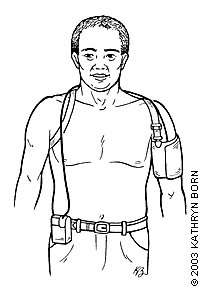
Am Fam Physician. 2003;67(11):2353-2354
What is high blood pressure?
Blood pressure is the force, or pressure, that pushes blood through the blood vessels in your body. In some people, it takes a lot of force. These people have what is called high blood pressure. Another word for it is hypertension.
Blood pressure is recorded as two numbers separated by a slash, like 120/80. The first number is the systolic pressure; it is the force when the heart pumps. The second number is the diastolic pressure; it is the force when the heart relaxes.(Say the words this way: sis-tol-ik, and die-uh-stol-ik.)
Knowing both of your pressure readings can help your doctor decide if you have high blood pressure. Your doctor will want you to keep your usual blood pressure lower than 140/90. If you are diabetic, your doctor will want you to keep a blood pressure lower than 130/85.
What causes high blood pressure?
Kidney and hormone problems can cause high blood pressure. Most of the time there is no known reason for high blood pressure. Your doctor can help you find out what might be causing your blood pressure to be high. Some common problems that can lead to high blood pressure are:
A diet high in fat and cholesterol
Not exercising regularly or not exercising hard enough
Being overweight
A family history of high blood pressure
Tobacco use
Stress
Some birth control medicines
Why do I have to control my high blood pressure?
High blood pressure can damage many parts of the body. If you have high blood pressure, you have a higher risk for strokes, heart disease, heart attacks, and kidney failure. Control of your blood pressure can reduce these risks.
You and your doctor will work together to find the best way to lower your blood pressure. Your doctor usually will ask you to change your diet and start exercising more. You may need to lose weight. Often, your doctor will talk to you about taking medicines to lower your blood pressure.
High blood pressure usually has no symptoms. The only way you can find out that your blood pressure is too high is to check it with a pressure monitor. The higher your blood pressure is, the more often you need to check it.
How can I check my blood pressure?
At first, your doctor will want you to come to the office regularly when you start treatment to lower your blood pressure. Your blood pressure will be checked at the office.
You also may be asked to check your blood pressure at home and to keep track of your “numbers” for your doctor. Your doctor may want you to check your blood pressure several times in a day. In this case, your doctor may have you use an ambulatory blood pressure monitor.
What is an ambulatory blood pressure monitor?
This is a small machine, about the size of a portable radio. You wear it on a belt. This machine lets your doctor find out what your blood pressure was every 15 to 30 minutes of a normal day. The picture below shows a person wearing an ambulatory blood pressure monitor.
It can be worn under your clothes without anyone seeing it. The information collected by this machine can help you and your doctor see if your blood pressure treatment is working.
Your doctor may want you to use an ambulatory blood pressure monitor for these reasons:
If you have “borderline” high blood pressure
If you and your doctor can't keep your blood pressure low
If you have blood pressure problems caused by your other medicines
If you are pregnant
If you have fainting spells
The monitor may help your doctor find out if you are a person who only has high blood pressure in the doctor's office (this is called “white-coat hypertension”). If you have this kind of hypertension, you may not need to take medicine.

What happens when I wear the monitor?
Usually nothing happens, but some people feel a little sore from the frequent pressure checks. Some people get a rash (it usually goes away without treatment).
The small blood pressure cuff that is connected to the monitor will automatically check your blood pressure about every 30 minutes, even while you are sleeping.
You also will be asked to keep a diary of your day's activities, so your doctor will know when you were active and when you were resting.
At the end of the day (24 hours), you will take the machine and your diary to the doctor's office. The information is transferred from the monitor to a computer. The computer helps the doctor make sense of the information.
You and your doctor will review the information and decide if your treatment program is working or if you need to make changes in it.
Where can I get more information about high blood pressure?
Your doctor
The American Academy of Family Physicians:www.familydoctor.org
The National Institutes of Health, National Heart, Lung, and Blood Institute:www.nhlbi.nih.gov/health/public/heart/index.htm